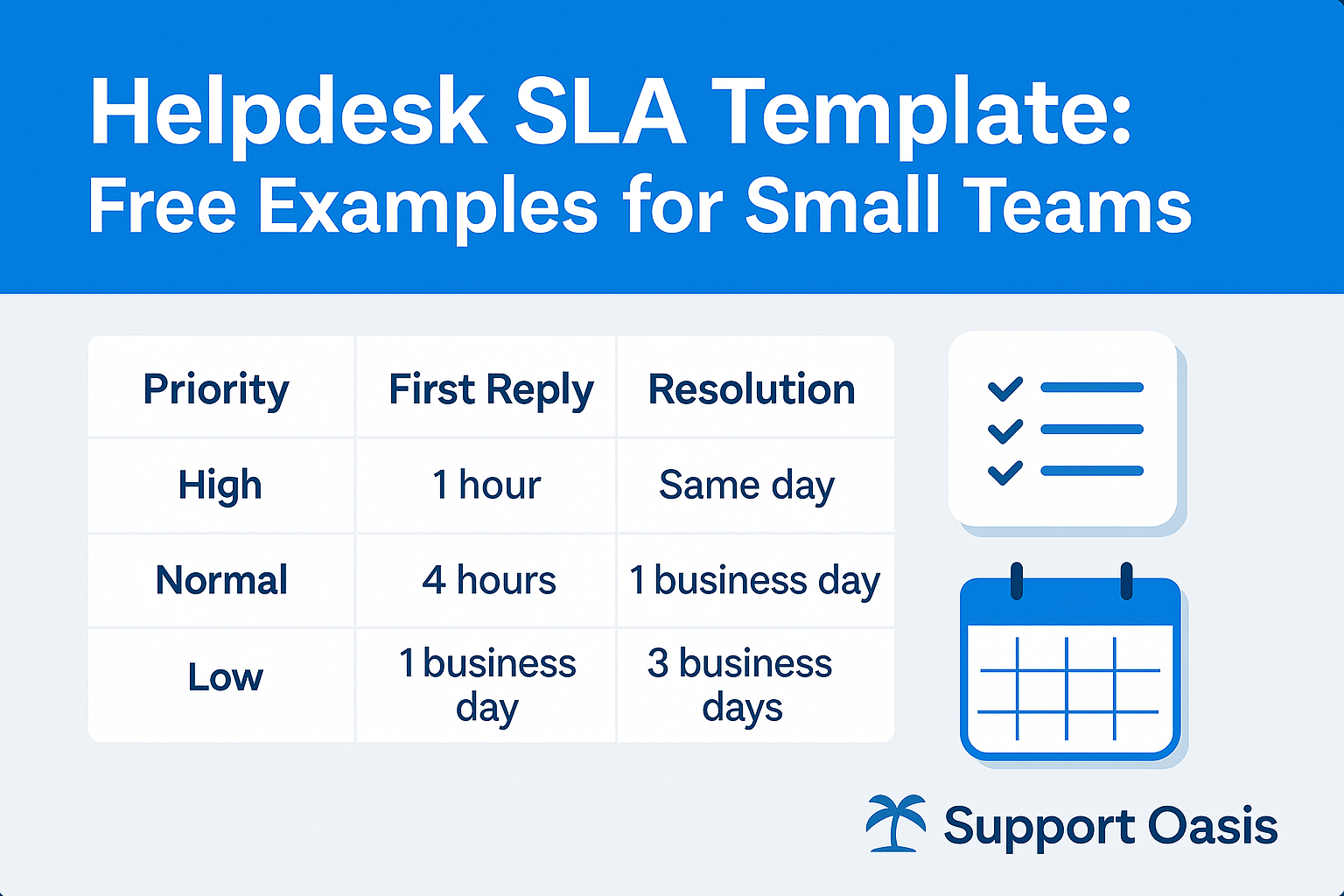A clear helpdesk SLA template gives small teams predictable response and resolution times. As a result, customers know what to expect, agents know what to do next, and leaders can spot risks early. In addition, simple wording keeps training fast.
Helpdesk SLA Template: What to Include
Your SLA should define ownership, timing, and communication. Therefore, include:
- Priorities and targets for first reply and resolution
- Update cadence during incidents
- Escalation tiers and on-call coverage
- “Waiting on customer” rules and auto close
- VIP handling and exceptions
For setup context, see How to Set Up a Helpdesk for Your Small Team in One Day and Email-Based Helpdesk: Simple Setup for Small Teams. For background on SLAs, review BMC’s guide to SLA examples and templates and Atlassian’s overview of SLA best practices.
Proposed SLA Targets and Definitions
Business hours example: Mon–Fri, 9:00–17:00 in your primary time zone. Outside that window, timers pause unless marked High.
Priority levels
- High: outage, login failure, payment errors, VIP
- Normal: product questions, minor bugs
- Low: feedback, feature ideas
Targets
- High: first reply 1 hour, resolution same day
- Normal: first reply 4 hours, resolution 1 business day
- Low: first reply 1 business day, resolution 3 business days
Update cadence during incidents
- High: update every 30–60 minutes until stable
- Normal: update every 2–4 hours if not yet resolved
Because targets drive behavior, publish them in onboarding and review monthly. When the team beats goals for two cycles, lower the numbers slightly.
Copy-Ready Helpdesk SLA Template
Purpose
Provide clear response and resolution targets for customer requests.
Scope
All email support tickets created in the helpdesk during business hours.
Priorities and targets
- High: first reply 1 hour, resolution same day, updates every 30–60 minutes
- Normal: first reply 4 hours, resolution 1 business day, updates every 2–4 hours
- Low: first reply 1 business day, resolution 3 business days
Escalation tiers
- Tier 1 Support: triage, troubleshooting, saved replies, customer updates
- Tier 2 Specialist: reproduce issues, propose workaround or fix
- Tier 3 Incident Lead: coordinate response, status page, credits if needed
Waiting on customer
If we request info and no reply arrives, auto remind after 48 hours and auto close after 7 days. Ticket reopens on customer reply.
VIP handling
VIP tickets inherit High by default. Include an update every 30–60 minutes during incidents.
After hours
High priority pages on-call. Normal priority queues for the next business day with an acknowledgment.
Helpdesk SLA Template Email Examples
Acknowledgment email (H3 uses keyphrase synonym)
Subject: We received your request
Body:
Hi {first_name}, thanks for reaching out. We are reviewing your request now. Our next update will be by {time}. If anything changes, reply to this email.
Ongoing update
Subject: Quick update on your request
Body:
Hello {first_name}, we are still working on this issue. Since the last update we {action taken}. Our next update will be by {time}.
Resolved notice
Subject: Your request is resolved
Body:
Good news, this request is now resolved. The cause was {simple explanation}. If you still see the issue, reply and we will help right away.
For tone and speed, you can adapt the templates from Helpdesk Saved Replies: 15 Templates for Small Teams. If you are moving off a shared inbox, compare options in Shared Inbox vs Helpdesk: Which Is Better for Small Teams?.
Reporting and Reviews
Track a small dashboard each week:
- First response time by priority
- Resolution time by priority
- SLA attainment percentage
- Backlog trend and reopen rate
Then run a fifteen minute review. Identify outliers, change one rule, and follow up next week. Consequently, you improve steadily without adding complexity.
Common Pitfalls and Fixes
- Vague language. Instead, write exact times and examples.
- Too many priorities. Start with three.
- No owner. Assign one person to maintain the SLA and the dashboard.
- No status updates. Add a next update time to every message.
Final Thoughts
This helpdesk SLA template gives small teams clarity, speed, and trust. In conclusion, set realistic targets, make updates predictable, and keep a simple review rhythm. As a result, customers feel informed and your team stays focused.
Ready to publish your SLA and hit it?
Try Support Oasis for free to track SLAs, send updates, and stay on schedule with simple dashboards. Try for free or learn more about Support Oasis.
